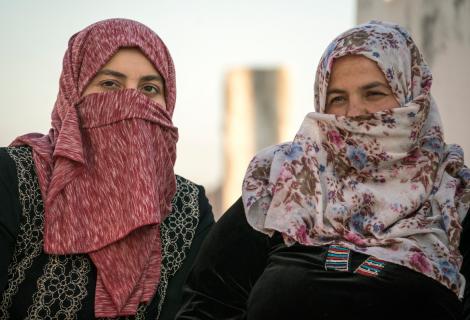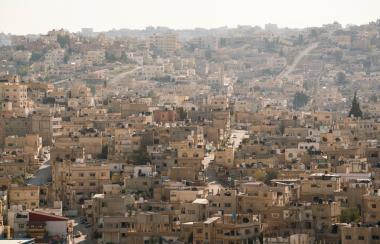How safe spaces for women and girls are strengthening the resilience of communities in Jordan.

By Becky Murphy global resilience advisor and Timothy Dean humanitarain and resilience assistant, ActionAid International

“We are getting ready and stronger and more able to cope with the help of NGOs such as ActionAid. We feel stronger because of the work we do here. We are more independent.”
(Women leader in Zarqa)
In February, a team of local women leaders from Mafraq and Zarqa, and ActionAid staff from Jordan, Lebanon and London, came together to explore how community resilience can be strengthened by women leaders in protracted, urban, ongoing and complex contexts such as the Syrian refugee crisis.
We know that women are disproportionately affected by conflict and protracted crisis. Women and girls suffer a double injustice in emergencies and humanitarian crises. Disasters and armed conflicts exacerbate existing gender inequalities, as women and girls are more vulnerable to the effects of emergencies, less able to access life-saving services and less likely to be part of decision-making that affects their lives. The current humanitarian response system is patriarchal, male-dominated and discriminates against women playing leadership roles.
But we also know that women are well placed to lead on building their community’s resilience and challenge the vulnerabilities and inequalities that persist. Local women-led resilience and humanitarian interventions not only support women to challenge their unequal position in society, but with their local knowledge, capacity and networks can also produce higher quality, more effective and more efficient programs than other approaches.
Therefore, at ActionAid we feel it is our role to prioritise a local woman-led approach to programming. Within this we also recognise the importance of aligning our humanitarian response, women’s protection, women’s empowerment and community resilience building work.
However, this can be challenging, and we’ve found that there is little guidance in the wider sector on how to do it in practice.
With funding from DANIDA, a team of ActionAid staff and local women leaders came together to try to figure out how we could practically support the women in our safe spaces to come together to build wider community resilience. While we are still on a learning journey, we thought we would share our reflections so far:
1. Why are women centres, safe spaces and protection work important for building community resilience?
Starting humanitarian interventions in complicated, urban, protracted crises by setting up women safe centres provides an important entry point to working with women who are traditionally marginalised and excluded from community decision making processes. It enables immediate women’s protection risks to be addressed while building trust, both with and among the women and the wider community.
It provides a safe space for women to come together, form friendships, allies and support. It offers a safe space for women to learn about their rights and be empowered to make changes in their community. It also provides an opportunity for tensions between groups (such as host and refugee communities) to be tackled through joint initiatives. When done well it can be transformative and empower women living in these challenging, often extremely conservative, contexts to have their voice heard and become leaders.
“We now know of the skills and positives that the Syrian refugees can bring to our community, since we have spent time with the Syrian women here, in this center, talked with them, spent time with them and learnt from them” (Jordanian women leader in Mafraq)
2. What did we do?
Twelve months after setting up safe spaces for women in Zarqa and Mafraq (part of our Syrian refugee crisis response) we worked with the women leaders to conduct vulnerability and capacity assessments. Here, we asked the women leaders to think about the risks and concerns of the wider community and what they felt could be done to mitigate these and strengthen community resilience. The women leaders worked together to develop risk timelines, maps, discuss key issues and develop action plans to start working on.
3. What did we learn?
When comparing this process to more traditional disaster risk reduction (DRR) process we learnt that this can be a powerful next step for ActionAid’s women leaders. The women leaders were supported to think about how their empowerment and skills can be used to strengthen the resilience not only their households and families but their wider neighbourhoods and communities.
When reflecting on more traditional DRR projects we also found that this process took more time than usual. More time was needed to support women to broaden their risk perception beyond protection issues; to include protection needs but also to reflect on wider issues and risks in the communities (such as unemployment, flood risks and lack of financial emergency safety nets).
Equally, when using the timeline exercise (a popular tool for such assessments) it was harder to reflect on life before and after the crises due to its protracted, on-going nature. Therefore, more time was required to unpack various spikes in the crisis and think about how the context has and is changing. Lastly, more time was needed to think through what advocacy work we could do with the women in this context. More work is needed to be done around the risk of advocacy and how it could link with support from our global advocacy work.
What happens next?
Our team in Lebanon will follow the same process in their Syrian refugee crisis women centre’s in Joub Jannine and Baalbek, and we will compare learnings and reflections.
The Jordan and Lebanon teams will support the women leaders to develop and roll out their action plans to build their communities resilience.
For more information about this work please contact Becky Murphy (global resilience adviser) at Rebecca.murphy@actionaid.org
For more information on ActionAid’s resilience tools please take a look at our Resilience Framework (https://actionaid.org/publications/2016/through-different-lens-actionaids-resilience-framework) and Resilience Handbook (https://actionaid.org/publications/2016/resilience-handbook).
A fresh perspective: ActionAid’s humanitarian and resilience team assistant, Timothy Dean, joined ActionAid’s resilience adviser in Jordan to support throughout this process. As a first timer for conducting an assessment with community leaders and visiting an ActionAid women’s safe space, we asked Tim for his reflections.
“This was my first opportunity to see the work that ActionAid does first-hand. This was also my first experience of a PVCA (Participatory Vulnerability and Capacity Assessment). The team were certainly equipped with the tools and confidence needed. However, this was not without challenges; for example, encouraging the women to focus on wider community resilience.
Whilst the PVCA clearly fits the mould in a DRR context, as the exercises progressed it was visible that these tools could also be applied in the protracted crisis. The timeline threw up some challenges such as defining what was meant by before and after the crisis when it is on-going, but it still got the women to think about their community and was a useful warm-up activity. The community mapping helped this and encouraged the women to think on a community-based level and less on personal experiences. The focus group really allowed us to draw on specific discussion points and vulnerabilities that the wider community may face.
The action plan developed made it clear to see that the level of passion and interest that these women had to share their thoughts and contribute to strengthening their community’s resilience. I am very excited and interested to see how the ideas put forward in the action plans can be developed and feel confident that the local women will endeavour to fulfil these to the max!”